HTTPS protects the communication between your browser and server from being intercepted and tampered with by attackers. This provides confidentiality, integrity and authentication to the vast majority of today’s WWW traffic.
Any website that shows a lock icon in the address bar is using HTTPS.

In this article, you’ll learn:
- The basics of HTTP and HTTPS
- How TLS certificates work
- How HTTPS helps SEO
- How to set up HTTPS
- How to check for potential HTTPS migration mistakes
First, let me simplify and illustrate the communication between the client (browser) and server when there’s an attacker in between.
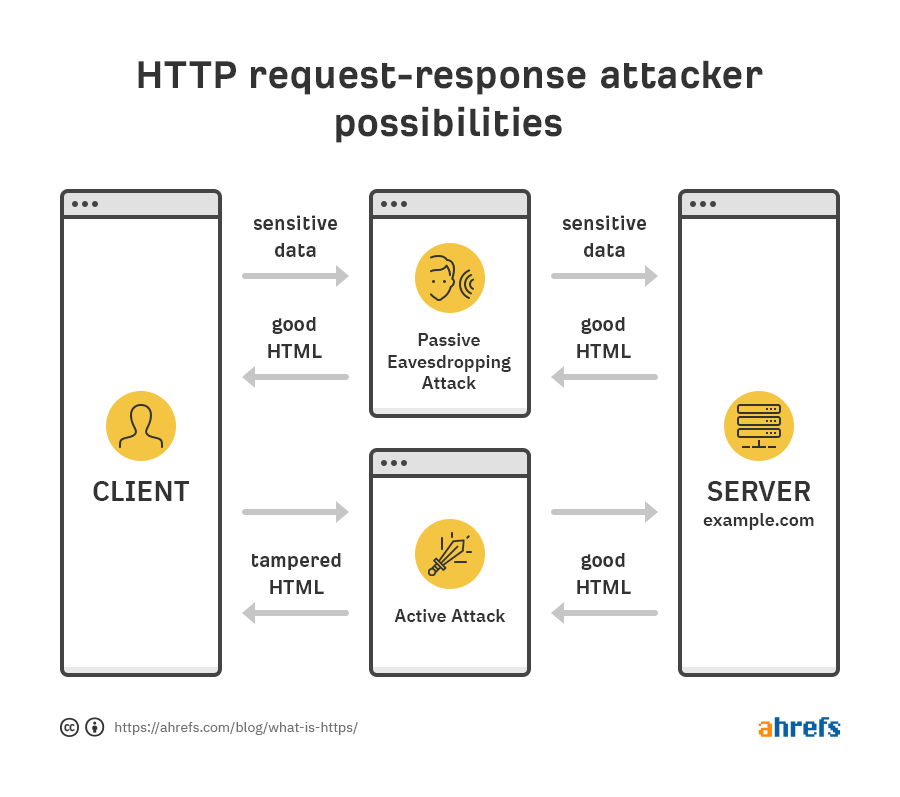
As you can see, attackers can get hold of sensitive data like login and payment details or inject malicious code into the requested resources.
Potential network attacks can happen anywhere with an untrusted router or ISP. Any public WiFi network is therefore vulnerable to such attacks. Fortunately, it seems that the general public is getting aware of this fact (increasing usage of VPNs).
However, the burden of making everyone’s browsing experience secure is and should be on webmasters.
That’s where the adoption of HTTPS comes into play.
HTTPS encrypts HTTP requests and responses so an intercepting attacker would only see random characters instead of credit card details, for example.
An analogy to how HTTPS works would be sending valuables in an indestructible locked combination box. Only the sending and receiving parties know the combination and if attackers get hold of it, they won’t get inside.
Now, a lot of things happen when a HTTPS connection is formed. Mainly, HTTPS relies on TLS (Transfer Layer Security) encryption to secure the connections.
The only way to enable HTTPS on your website is to get a TLS certificate and install it on your server. You’ll also encounter it as an SSL or SSL/TLS certificate but don’t worry, it’s all the same thing. SSL is still widely used terminology even though we all technically use its successor TLS.
TLS certificates are issued by Certificate Authorities (CA). The role of CA is to be a trusted third-party in the client-server relationship. Basically, anyone can issue TLS certificates but only the publicly trusted CAs are supported by browsers.
You can check every website’s TLS certificate and its issuing CA by clicking on the lock icon in your browser’s address bar.
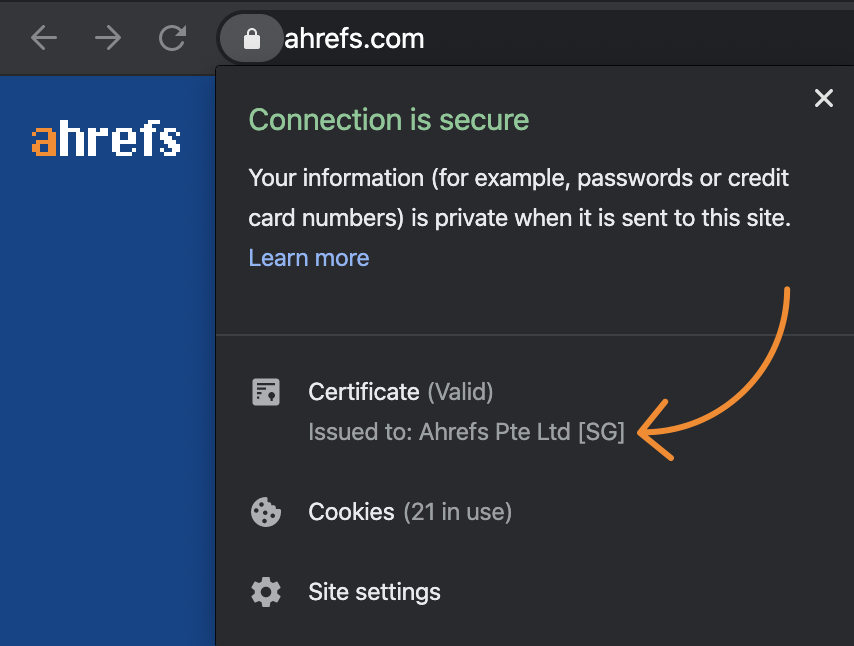
You can click through the certificate to learn more. The important thing here is the “Issued to:” line. This is when we get into different types of validation standards for TLS certificates, which is what mainly sets the free and paid certificates apart.
DV, OV and EV: What does it mean and which one to choose?
Free TLS certificates that come with your hosting and CDN plans only do domain validation (DV). This validates that a certificate owner controls a given domain name. Such a basic validation technique is good enough for blogs and websites that don’t handle sensitive information, but isn’t ideal for those that do.
Websites using a DV TLS certificate appear secure but you won’t see the “Issued to:” line when you click the lock icon.
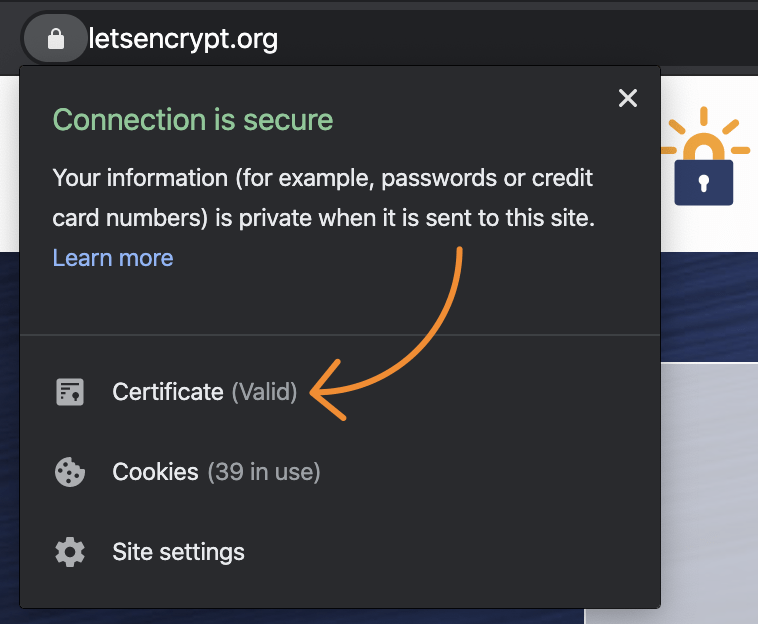
The most common DV TLS certificate comes from a non-profit CA called Let’s Encrypt. That’s what most companies offering free automatically renewable TLS certificates use.
There’s nothing wrong with DV-only certificates, after all it’s the only type of TLS certificate that can be automatically issued at scale. However, HTTPS is only as strong as the underlying certificate that authenticates the server you’re talking to.
If your website allows logins or payments, you should invest in a TLS certificate that offers organization validation (OV) or extended validation (EV). These two types differ in the verification process with the EV being more rigorous.
If you’re looking to buy just one, I’d recommend going straight for the EV TLS certificate. It’s the most trustworthy one and it doesn’t cost much more than OV.
Wildcard and SAN TLS certificates
Leaving validation standards behind, let’s move onto another category of TLS certificates.
Wildcard and SAN certificates are used to secure multiple (sub)domains at once. If you bought a standard EV TLS certificate for example.com, you’d need a separate certificate for blog.example.com.
Wildcard certificates can secure unlimited subdomains (example.com, blog.example.com, docs.example.com) while SAN certificates also have the option to secure other domains as well (example.com, blog.example.com, different.org).
These types are combined with the validation types so you’ll see all sorts of combinations when you browse through the options CAs offer. They will also guide you through the validation process.
Pretty much all the benefits of HTTPS tie back to SEO:
- Lightweight ranking signal
- Better security and privacy
- Preserves referral data
- Enables the use of modern protocols that enhance security and site speed
Lightweight ranking signal
Google announced that HTTPS is a lightweight ranking factor way back in 2014. It’s more like a tiebreaker than something that would skyrocket your rankings if other ranking factor variables remained unchanged.
This is basically Google’s contribution to faster worldwide HTTPS adoption.
Better security and privacy
We already talked about this one. But how is this connected to SEO?
When you land on an unsecure website, you’ll see something like this:
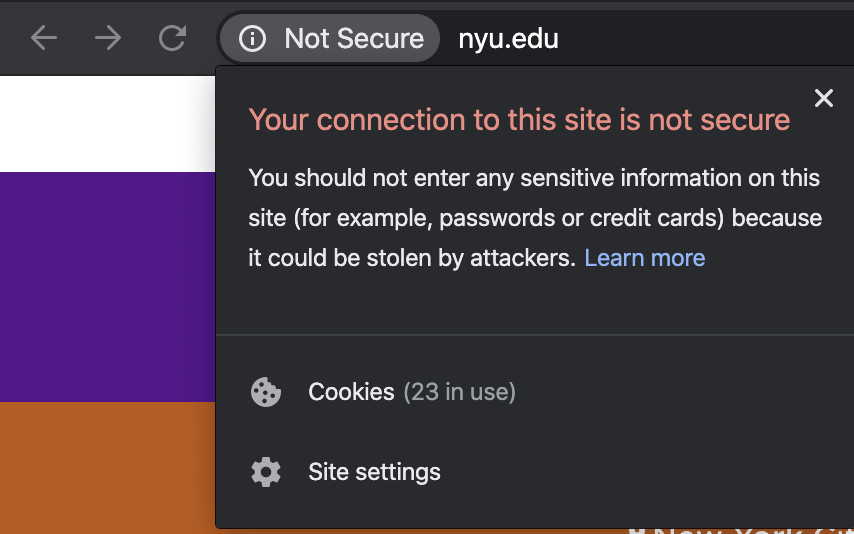
It doesn’t really build trust, right? I’m aware of my professional bias but I personally pay attention to this and quickly form a bad first impression if I see that on any website.
My guess is that migrating to HTTPS can improve dwell time and prevent pogo sticking. While these are only theorised (not confirmed) ranking factors, making people ‘stick’ when they land on your website is something you want regardless of SEO.
Preserves referral data
If your website is still on HTTP and you’re using web analytics services like Google Analytics, I have bad news for you: No referral data is passed from HTTPS to HTTP pages.
As most of the web runs on HTTPS these days, the source of most referral traffic (clicks on links from other websites) will be labeled as direct in most analytics software.
One disadvantage of this is that it makes your data messy and skewed. Another is that you’re unable to see your best referral sources—which is a wasted link building opportunity.
Enables the use of modern protocols that enhance security and site speed
On paper, HTTPS is slower than HTTP because of the added security features. However, having HTTPS is the prerequisite for using the latest security and web performance technology.
In other words, besides security, HTTPS also enables your website to improve its page speed when you use protocols like TLS 1.3 and HTTP/2. And apart from better user experience, Google considers page speed as a lightweight ranking factor similar to HTTPS:
Ranking wise it’s a teeny tiny factor, very similar to https ranking boost. That particular one is not surprising. You do that primarily to enable users to convert.— Socially distant Gary Illyes (@methode) April 28, 2020
This depends on your scenario.
1. You’re launching a new website
You’ve won the lottery. Go with HTTPS from the beginning and you won’t ever have to worry about HTTP and errors associated with the migration.
All you need to do is to have a good hosting provider that will guide you through the process, and that supports the latest HTTP and TLS protocol versions. After all is up and running, implement HSTS as the last step to seal the security.
2. You already have an HTTPS-enabled website
The fact that you’re reading this article tells me that it’s probably not set up correctly. Follow the advice in the next section to check for common errors.
3. You still have a website running on HTTP
It will take a while to get everything prepared and done. The complexity of the migration depends on:
- The size and complexity of your website
- What kind of CMS you use
- Your hosting/CDN providers
- Your technical abilities
While I believe that owners of small websites running on popular CMS and solid hosting can do the migration themselves, there are a lot of variables at play.
I suggest you check the documentation of your CMS/server/hosting/CDN and proceed accordingly—and with caution. There are quite a lot of steps you need to execute so create or follow a migration checklist and don’t try to fit in other activities.
If all of this sounds too technical for you, hire a professional. It will save you hours of your time, save your nerves, and ensure future-proof implementation.
Even if you ticked off the whole HTTPS migration checklist, chances are that you’ll still encounter some issues.
In fact, back in 2016, we analyzed 10,000 top-ranking domains for various HTTPS mistakes and found the following:
- 90.9% of domains had sub-optimal HTTPS implementation
- HTTPS was not working correctly on 65.39% of domains
- 23.01% of domains were using temporary 302 redirects instead of permanent 301s
While a lot has changed and improved since then, I’d recommend that you check for the five common HTTPS migration mistakes below. It won’t take long, and most of them aren’t that hard to fix.
Mistake 1: HTTP pages left
First and foremost, you need to make sure that all pages on your site are already on HTTPS.
You can discover leftover HTTP pages by thoroughly crawling the website. This shouldn’t be anything new if you stuck to any HTTPS migration checklist. Just make sure that the crawler has all the required URL sources so it doesn’t leave pages behind.
To do that, you can use Ahrefs Webmaster Tools for free with the following setup:
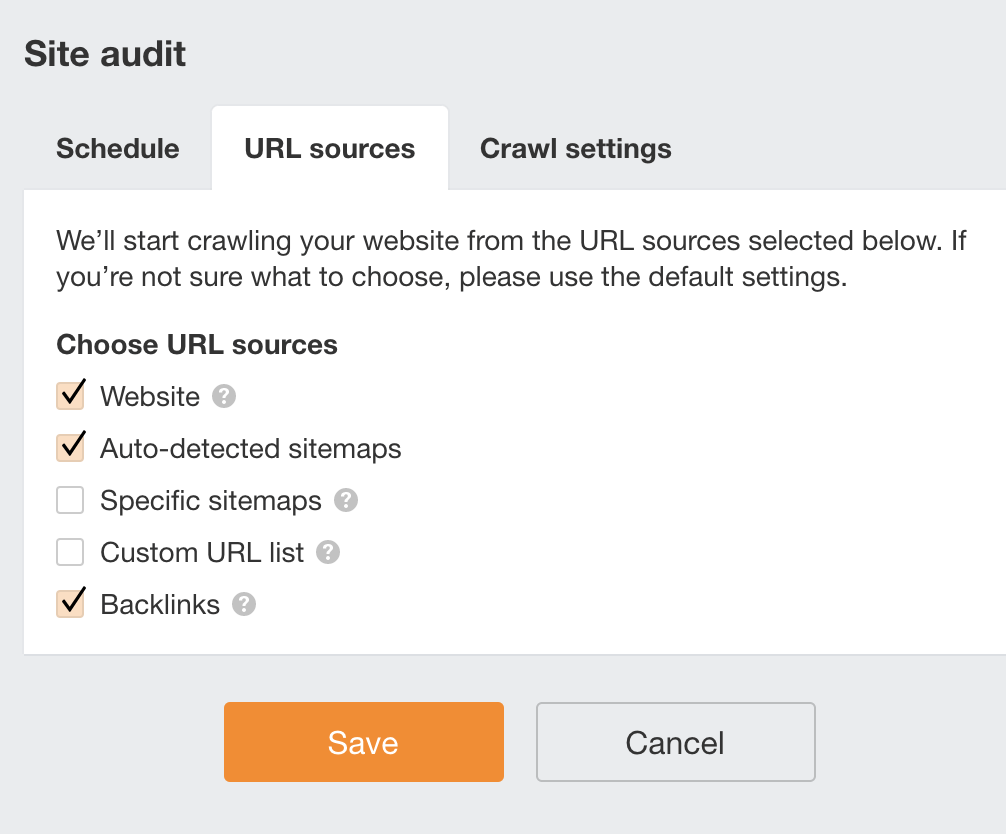
After it’s done, open the latest crawl, go to Page Explorer and apply the following filter:

Export the list of HTTP URLs and redirect them to finish the migration.
Pages that are not in your sitemap and have zero links pointing to them are impossible to discover by crawling. This can often happen with dedicated PPC landing pages. One way to find these is to export the URL list from your ads managers like Google Ads or FB Business Manager.
From there, make sure the orphaned pages were migrated properly. And don’t forget to update them in your campaign dashboards to the newer HTTPS format.
Mistake 2: HTTPS pages with HTTP content
This mistake occurs when the initial HTML file is loaded using HTTPS but its resource files (images, CSS, JavaScript) haven’t been updated to HTTPS yet.

If this is an issue on your website, you’ll see it both in the crawl overview and Internal pages report. All errors, warnings and notices in the free Ahrefs Webmaster Tools contain a description of the issue and advice on how to fix it.
Mistake 3: Internal links not updated to HTTPS
Not updating your internal links to HTTPS causes unnecessary redirects. That’s obviously better than landing on an HTTP page but we’ve already gone through this mistake. It’s easy to spot these links and fix them.
You’ll find this issue under the Links report in Site Audit within Ahrefs Webmaster Tools:

Just rewrite the URLs to https:// and you’re done. This is only applicable if you’ve already made sure that no HTTP pages are left using the advice under mistake #1.
Mistake 4: Tags not updated to HTTPS
There are two types of tags you might be using on your website that also need their URLs updating to HTTPS: Canonical tags and Open Graph tags.
Canonical tags tell Google what you consider to be the most authoritative page from a bunch of similar or duplicate pages. Pointing that to an HTTP version can definitely send a bad signal to Google and will be most likely ignored.
If you use Open Graph tags to optimize your social media posts, then URL tags are required by Facebook. They should be the same as canonical URLs.
To find pages with HTTP canonical and OG tags, set up this custom filter in Page Explorer:
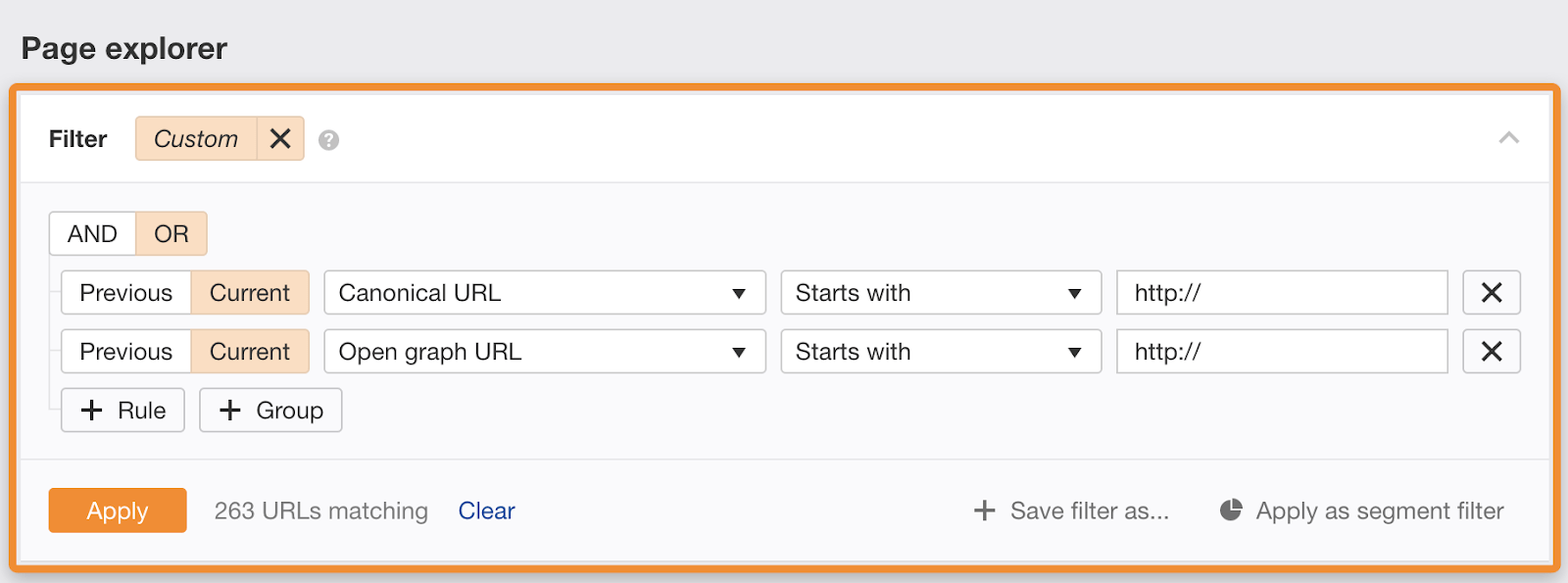
Again, all that’s left is to rewrite them to https:// given a completely finished migration.
Mistake 5: Failed redirects
Redirects can be tricky. There’s quite a lot that could go wrong—from broken redirects, to redirect chains and loops.
Fortunately, it’s easy to spot these errors with Site Audit. Just check the Redirects report and go through all the issues.
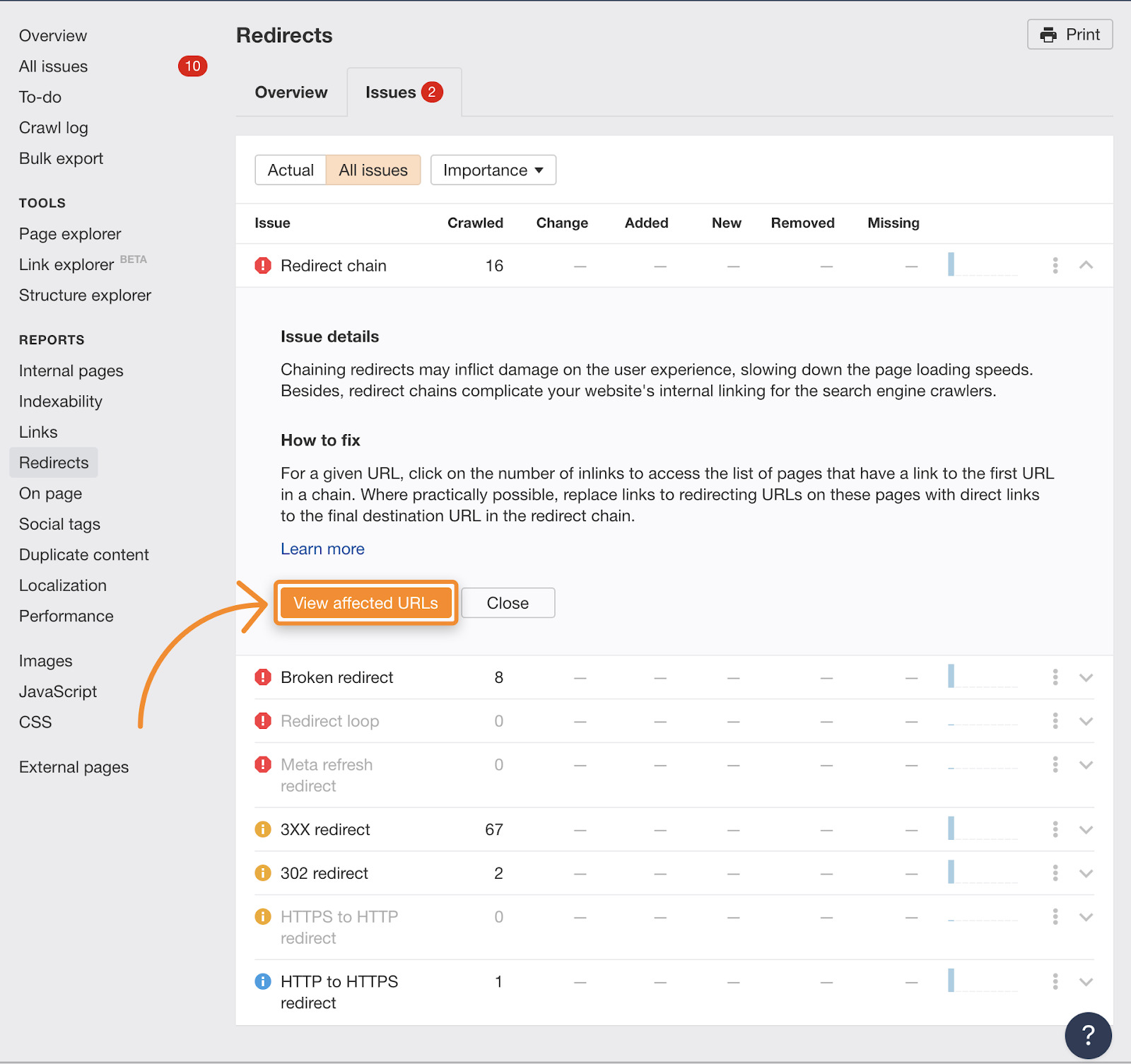
After you click on the “View affected URLs” button, you’ll see a report similar to this, just with more default columns and metrics:

The best thing here is that you’ll really see all the affected URLs—the redirected ones, ones inside the redirect chain, and those that link to the redirected ones.
There are two things you should do here.
The first one is splitting up the redirects, in this case:
https://blog.example.com/123/> -> 301 redirect -> >https://example.com/blog/987/
This would ensure that all backlinks pointing to both https://blog.example.com/123/ and https://example.com/blog/123/ would be redirected only once. That’s fine for external backlinks as reaching out to webmasters with link edit requests would be highly ineffective and quite annoying.
We can do better internally though.
You should strive for the least number of redirects. That’s when the number of inlinks column comes into play.
Inlinks are URLs that link to the URL affected by the redirect chain. You’ll want to swap the links on those pages for URLs that return a 200 HTTP status code. If you click through the number of inlinks, you’ll see all of them:

Of course, again, the next step would be checking the inlinks of the URLs within the redirect chain. However, that’s of a lower priority as we already broke the redirect chain. These would be tagged as standard 301 redirects in the 3XX Redirects report upon the next crawl.
Final thoughts
I hope that together we can make browsing the World Wide Web faster and more secure.
According to w3techs.com, 59.4% of websites in their survey sample use HTTPS by default. In comparison, Google reports that between 88-99% of browsing time in Chrome is spent on HTTPS websites.
My takeaway from this data is that the vast majority of popular websites with considerable traffic have already shifted to HTTPS. If you’re wondering about the big difference in those two data points, then I would attribute that to Chinese websites which aren’t included in Google’s data.
There’s still much to be desired in terms of the quality of TLS support though. As you’ve learnt here, HTTPS setup doesn’t end with the migration process. Keeping up with the trends in web performance and security and implementing the newest features benefits everyone involved.
Do you have any questions or comments? Ping me on Twitter.




